 Automakers constantly strive to make new cars, trucks and SUVs as safe as possible. The design and materials used in new vehicle chassis make them stronger, more rigid and safer than ever before. Technologies like backup cameras, blind spot monitoring, active lane keep assist, multi-view camera systems, rear cross traffic alerts and autonomous braking dramatically reduce the chance of having an accident. Up until only a few years ago, you had to buy all of these technologies that are now already on your new vehicle. Thankfully, your local mobile enhancement retailer can now retrofit some of these collision avoidance solutions into almost any vehicle. Read on to find out about the options that are available to add safety to your next commute or road trip.
Automakers constantly strive to make new cars, trucks and SUVs as safe as possible. The design and materials used in new vehicle chassis make them stronger, more rigid and safer than ever before. Technologies like backup cameras, blind spot monitoring, active lane keep assist, multi-view camera systems, rear cross traffic alerts and autonomous braking dramatically reduce the chance of having an accident. Up until only a few years ago, you had to buy all of these technologies that are now already on your new vehicle. Thankfully, your local mobile enhancement retailer can now retrofit some of these collision avoidance solutions into almost any vehicle. Read on to find out about the options that are available to add safety to your next commute or road trip.
Backup Camera Systems
 The simplest of safety systems is a backup camera system. More and more vehicles come with this technology built in and thankfully, there are aftermarket solutions for almost every possible application. In many instances, you can choose to have the camera image displayed on a factory color screen. If your car doesn’t have a color display, you may want to opt for a new rearview mirror with a built-in screen. For commercial usage, stand-alone monitors are available. These are popular on delivery trucks, tow trucks, snow plows and commercial equipment.
The simplest of safety systems is a backup camera system. More and more vehicles come with this technology built in and thankfully, there are aftermarket solutions for almost every possible application. In many instances, you can choose to have the camera image displayed on a factory color screen. If your car doesn’t have a color display, you may want to opt for a new rearview mirror with a built-in screen. For commercial usage, stand-alone monitors are available. These are popular on delivery trucks, tow trucks, snow plows and commercial equipment.
Parking Sensor Systems
Working hand-in-hand with the benefits of a backup camera to let you know if something or someone is behind your vehicle, an aftermarket parking sensor system provides an audible warning when there is a chance you may bump into an object. Premium parking sensor systems change the frequency of their warning beeps to let you know when you are getting close to an object.
Blind Spot Monitoring Systems
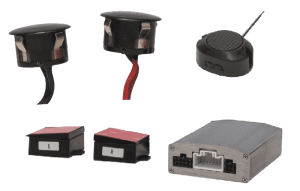 Aftermarket blind spot monitoring systems are just entering their second generation. These systems include a pair of radar sensors that are mounted behind the rear bumper cover to monitor the space on either side of your vehicle for another car or truck. The exact function of these systems varies from one brand to another. Make sure that the solution you choose can detect a vehicle that has entered your blind spot from the side or that you have passed. Many will only alert you if the vehicle enters your blind spot from the rear.
Aftermarket blind spot monitoring systems are just entering their second generation. These systems include a pair of radar sensors that are mounted behind the rear bumper cover to monitor the space on either side of your vehicle for another car or truck. The exact function of these systems varies from one brand to another. Make sure that the solution you choose can detect a vehicle that has entered your blind spot from the side or that you have passed. Many will only alert you if the vehicle enters your blind spot from the rear.
Several companies now offer camera-enhanced blind spot monitoring systems that automatically display an image of the area on either side of your vehicle when you activate your turn signal.
Cross Traffic Alert Systems
 Most of the radar-based blind spot monitoring systems on the market switch to a rear cross traffic alert system when you are backing up. These systems extend the radar signal to as much as 100 feet on either side of your vehicle to watch for oncoming cars or trucks. When they detect something, the same LED indicators that warn you about a vehicle in your blind spot will flash to let you know what side the vehicle is approaching from. Many systems include an audible alarm to make sure you know something is approaching.
Most of the radar-based blind spot monitoring systems on the market switch to a rear cross traffic alert system when you are backing up. These systems extend the radar signal to as much as 100 feet on either side of your vehicle to watch for oncoming cars or trucks. When they detect something, the same LED indicators that warn you about a vehicle in your blind spot will flash to let you know what side the vehicle is approaching from. Many systems include an audible alarm to make sure you know something is approaching.
Multi-View Camera Systems
 Though still in their infancy in the aftermarket, “surround view” camera solutions are offered by several companies. This technology uses four cameras mounted around your vehicle to create a virtual aerial view of your car or truck. The camera image is akin to looking down at your vehicle from about 30 feet above the roof. You can see parking lines, curbs and the presence of other vehicle or obstacles.
Though still in their infancy in the aftermarket, “surround view” camera solutions are offered by several companies. This technology uses four cameras mounted around your vehicle to create a virtual aerial view of your car or truck. The camera image is akin to looking down at your vehicle from about 30 feet above the roof. You can see parking lines, curbs and the presence of other vehicle or obstacles.
Collision Avoidance Alert Systems
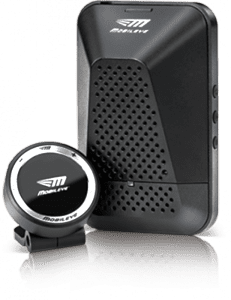 Aftermarket safety systems that will apply your brakes or move the steering wheel are not currently available. Those technologies require careful calibration that is specific to each application. One technology that is available is a forward-facing collision warning system. MobileEye is the company responsible for the original autopilot technology used on Tesla vehicles. They offer several aftermarket solutions that use a camera and an advanced image processing computer to warn the driver if someone is approaching from the side or if he or she is approaching a stopped vehicle too quickly. A small display on the dash provides visual alerts to give you extra time to slow down.
Aftermarket safety systems that will apply your brakes or move the steering wheel are not currently available. Those technologies require careful calibration that is specific to each application. One technology that is available is a forward-facing collision warning system. MobileEye is the company responsible for the original autopilot technology used on Tesla vehicles. They offer several aftermarket solutions that use a camera and an advanced image processing computer to warn the driver if someone is approaching from the side or if he or she is approaching a stopped vehicle too quickly. A small display on the dash provides visual alerts to give you extra time to slow down.
These systems can also alert you if you are leaving your lane without signaling first — a sign that you may not be focusing on the task of driving safely.
Dash Camera Systems and Digital Video Recorders
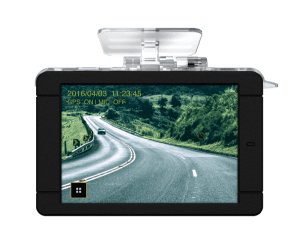 Though not a collision avoidance technology, a video recording system in your vehicle can protect you from fraud or faulty accusations. These camera systems record everything that happens in front of the vehicle from the moment you start the engine to the second you arrive at your destination. If someone backs into you and says you hit them, you can show the police video of the event. If you happen to witness an accident, sharing the video with the authorities can help the reconstruct the events that led up to the incident. Though not officially endorsed by insurance companies, we know of several cases where dashcam video evidence has saved vehicle owners from dramatic insurance rate increases after an accident.
Though not a collision avoidance technology, a video recording system in your vehicle can protect you from fraud or faulty accusations. These camera systems record everything that happens in front of the vehicle from the moment you start the engine to the second you arrive at your destination. If someone backs into you and says you hit them, you can show the police video of the event. If you happen to witness an accident, sharing the video with the authorities can help the reconstruct the events that led up to the incident. Though not officially endorsed by insurance companies, we know of several cases where dashcam video evidence has saved vehicle owners from dramatic insurance rate increases after an accident.
Protect Yourself and Your Vehicle With Modern Technology
Whether you choose a simple backup camera to make parking and maneuvering safer or you outfit your vehicle with advanced collision warning technologies, any upgrade can help you operate your vehicle more safely and reduce the risk of injury or accident. For more information about what is available for your specific make and model of vehicle, drop by your local specialist mobile enhancement retailer today.
This article is written and produced by the team at www.BestCarAudio.com. Reproduction or use of any kind is prohibited without the express written permission of 1sixty8 media.
 It’s the middle of the summer, and
It’s the middle of the summer, and  We can’t even fathom the number of audio system upgrades we see installed at big meets and rallies like Daytona, Sturgis, Laconia and Myrtle Beach. While leaving your pride and joy with the guys in a booth or trailer to upgrade your stereo while you grab lunch or dinner sounds incredibly convenient, occasionally long-term issues dramatically reduce the value of this purchasing option.
We can’t even fathom the number of audio system upgrades we see installed at big meets and rallies like Daytona, Sturgis, Laconia and Myrtle Beach. While leaving your pride and joy with the guys in a booth or trailer to upgrade your stereo while you grab lunch or dinner sounds incredibly convenient, occasionally long-term issues dramatically reduce the value of this purchasing option.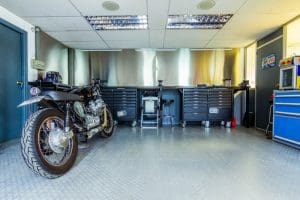 When you pull up to a shop to have your
When you pull up to a shop to have your 
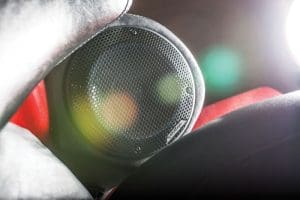
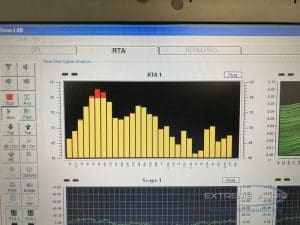
 Apple CarPlay and Android Auto smartphone integration
Apple CarPlay and Android Auto smartphone integration  These infotainment solutions require two components to provide you with Internet-connected voice recognition access to your music, navigation and communication functions. First and foremost, the source unit in the vehicle needs to have the software built in. Including
These infotainment solutions require two components to provide you with Internet-connected voice recognition access to your music, navigation and communication functions. First and foremost, the source unit in the vehicle needs to have the software built in. Including 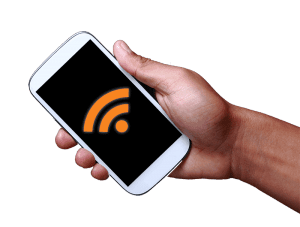 Up until recently, the connection between your phone and the radio for CarPlay and Android Auto has used a USB cable. With the introduction of wireless connectivity, things have changed. A Wi-Fi connection between your source unit and your smartphone replaces the wired connection for reliable, high-speed communication. Initially, a little more setup is required to get your smartphone and radio talking, but once configured, everything operates intuitively.
Up until recently, the connection between your phone and the radio for CarPlay and Android Auto has used a USB cable. With the introduction of wireless connectivity, things have changed. A Wi-Fi connection between your source unit and your smartphone replaces the wired connection for reliable, high-speed communication. Initially, a little more setup is required to get your smartphone and radio talking, but once configured, everything operates intuitively. In November 2017, Google announced the ability for devices running Android to run Android Auto as a stand-alone app without the need for an aftermarket source unit. At CES 2018, several aftermarket manufacturers announced they would include wireless Android Auto connectivity on their new source units.
In November 2017, Google announced the ability for devices running Android to run Android Auto as a stand-alone app without the need for an aftermarket source unit. At CES 2018, several aftermarket manufacturers announced they would include wireless Android Auto connectivity on their new source units.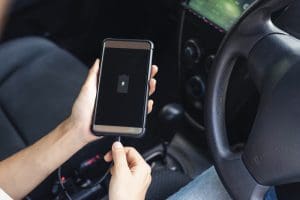 There are have been many discussions about the benefits and drawbacks of wireless connectivity. The biggest point of debate is around phone charging. In most cases, drivers take advantage of the ability to charge their phones when they get in their vehicles as they travel. For most people, this requires that the USB cable is connected to their phone. With that said, the Apple iPhone 8, 8 Plus and X include wireless charging. On the Android side, recent devices from Samsung, LG, Google, Microsoft and Blackberry include wireless charging.
There are have been many discussions about the benefits and drawbacks of wireless connectivity. The biggest point of debate is around phone charging. In most cases, drivers take advantage of the ability to charge their phones when they get in their vehicles as they travel. For most people, this requires that the USB cable is connected to their phone. With that said, the Apple iPhone 8, 8 Plus and X include wireless charging. On the Android side, recent devices from Samsung, LG, Google, Microsoft and Blackberry include wireless charging.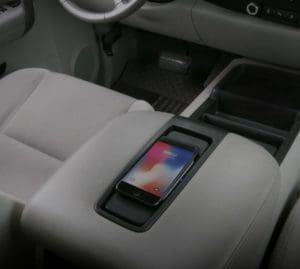 Flipping back to the cons side of the debate, you need a wireless charging base in your vehicle to take advantage of the wireless charging feature. Vehicles from Audi, BMW, Chrysler, Ford, Honda, Mercedes-Benz, Toyota, Volkswagen and Volvo include Qi compatible charging solutions. Qi is the standard for wireless charging for Apple devices.
Flipping back to the cons side of the debate, you need a wireless charging base in your vehicle to take advantage of the wireless charging feature. Vehicles from Audi, BMW, Chrysler, Ford, Honda, Mercedes-Benz, Toyota, Volkswagen and Volvo include Qi compatible charging solutions. Qi is the standard for wireless charging for Apple devices.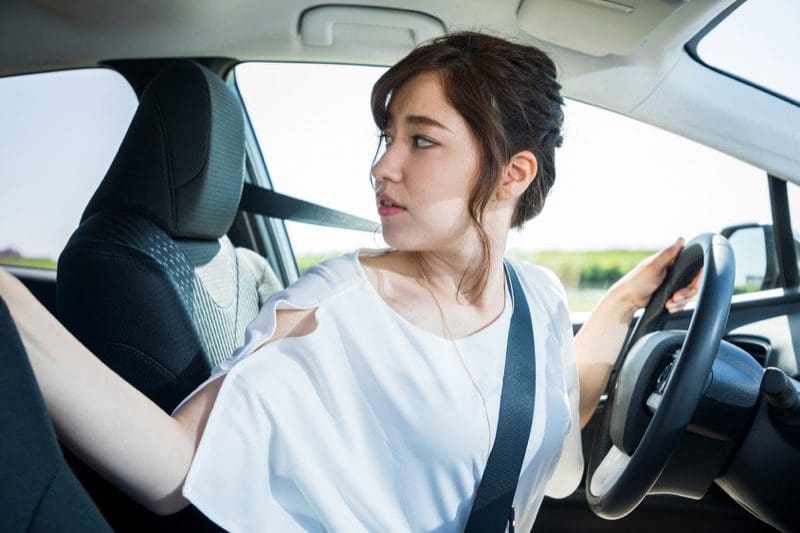 Back over accidents are responsible for more than 200 deaths and 12,000 injuries each year. The US Congress passed a law in 2008 that would enact measures to use technology to prevent accidents like these. After years of delays, the US Department of Transportation finally announced that new cars must come with a backup camera.
Back over accidents are responsible for more than 200 deaths and 12,000 injuries each year. The US Congress passed a law in 2008 that would enact measures to use technology to prevent accidents like these. After years of delays, the US Department of Transportation finally announced that new cars must come with a backup camera. In the simplest of terms, a
In the simplest of terms, a  Most factory-installed cameras are mounted above the license plate on a car or in the handle or tailgate emblem of a truck. Aftermarket camera solutions are available to mimic these installation locations. Many vehicles like the Mercedes Sprinter, Ford F-150 and GMC Silverado and Chevy Sierra have aftermarket solutions that look identical to factory offerings. The cameras are water resistant and carry an IP66 (or higher) dust and water intrusion rating. This IP rating means that the cameras can withstand going through the car wash or exposure to the everyday challenges Mother Nature throws their way. Universal cameras are available in surface and flush mount applications. Your mobile enhancement retailer can help you choose the right style for your application.
Most factory-installed cameras are mounted above the license plate on a car or in the handle or tailgate emblem of a truck. Aftermarket camera solutions are available to mimic these installation locations. Many vehicles like the Mercedes Sprinter, Ford F-150 and GMC Silverado and Chevy Sierra have aftermarket solutions that look identical to factory offerings. The cameras are water resistant and carry an IP66 (or higher) dust and water intrusion rating. This IP rating means that the cameras can withstand going through the car wash or exposure to the everyday challenges Mother Nature throws their way. Universal cameras are available in surface and flush mount applications. Your mobile enhancement retailer can help you choose the right style for your application.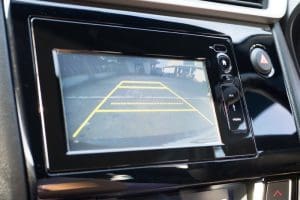 If your car or truck came with a color display for the factory radio or infotainment system, there are many companies that offer premium integration modules that allow the image from the backup camera to be displayed on this screen. Using a factory screen is the most integrated of solutions and truly mimics a factory-installed system.
If your car or truck came with a color display for the factory radio or infotainment system, there are many companies that offer premium integration modules that allow the image from the backup camera to be displayed on this screen. Using a factory screen is the most integrated of solutions and truly mimics a factory-installed system.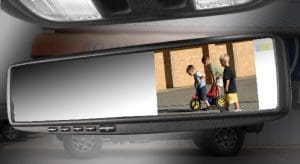 If your vehicle doesn’t have a color screen, another popular option to display a camera image is a replacement rearview mirror that features an integrated color display. When the camera is not in use, the mirror looks normal and will show you what is happening behind your vehicle. When you put the transmission in reverse, a compact LCD screen shines through the mirrored surface to display the camera image. While typically small in size (around 4 inches diagonally), they work very well and are quite popular.
If your vehicle doesn’t have a color screen, another popular option to display a camera image is a replacement rearview mirror that features an integrated color display. When the camera is not in use, the mirror looks normal and will show you what is happening behind your vehicle. When you put the transmission in reverse, a compact LCD screen shines through the mirrored surface to display the camera image. While typically small in size (around 4 inches diagonally), they work very well and are quite popular.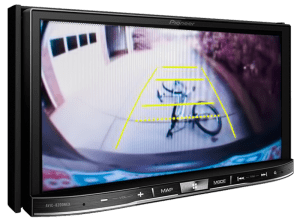 A popular upgrade for older vehicles is to replace the
A popular upgrade for older vehicles is to replace the 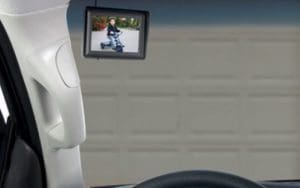 If none of the above options suit your application or you require a larger screen, then consider having a stand-alone monitor installed in your vehicle. Commercial applications such as tow trucks, snow plows, garbage trucks, recycling trucks and delivery vehicles often choose a stand-alone monitor. The image is large, and the unit can be placed in a convenient location.
If none of the above options suit your application or you require a larger screen, then consider having a stand-alone monitor installed in your vehicle. Commercial applications such as tow trucks, snow plows, garbage trucks, recycling trucks and delivery vehicles often choose a stand-alone monitor. The image is large, and the unit can be placed in a convenient location.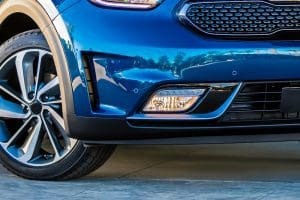 Many luxury vehicles combine a
Many luxury vehicles combine a 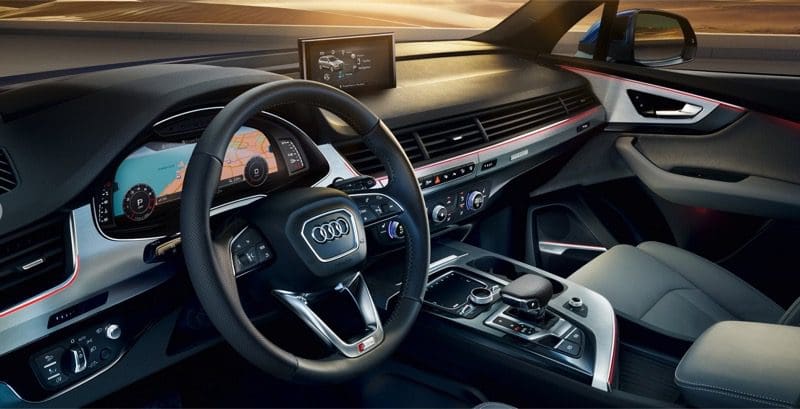 Did you know that you can get great sound in your car or truck using your
Did you know that you can get great sound in your car or truck using your 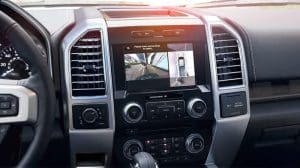 Fewer and fewer cars today have radios that only play music. They show
Fewer and fewer cars today have radios that only play music. They show  In the good old days, factory audio systems included a radio, a simple analog amplifier and speakers. If you had a luxury vehicle, the manufacturer may have opted to include a subwoofer for a little more (but still not enough) bass. The radio was a simple affair with a tuner, CD player, auxiliary input and maybe a USB port and satellite radio connection. The output of the radio either powered the speakers in the car directly or fed a signal to a small amplifier.
In the good old days, factory audio systems included a radio, a simple analog amplifier and speakers. If you had a luxury vehicle, the manufacturer may have opted to include a subwoofer for a little more (but still not enough) bass. The radio was a simple affair with a tuner, CD player, auxiliary input and maybe a USB port and satellite radio connection. The output of the radio either powered the speakers in the car directly or fed a signal to a small amplifier.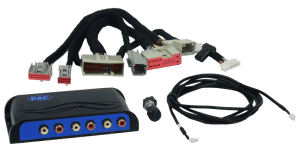 Let’s look at three common upgrades that mobile electronics retailers across the nation perform every day. Since 2009, the Ford F-150 has come equipped with an amplifier in the back of the truck that includes the master volume control for the system as well as equalization and crossovers for the speakers. Upgrading this popular vehicle required summing audio signals coming out of the amp back together and removing signal processing.
Let’s look at three common upgrades that mobile electronics retailers across the nation perform every day. Since 2009, the Ford F-150 has come equipped with an amplifier in the back of the truck that includes the master volume control for the system as well as equalization and crossovers for the speakers. Upgrading this popular vehicle required summing audio signals coming out of the amp back together and removing signal processing. Another popular audio system upgrade interface is the iDatalink Maestro DSR1. Automotive Data Solutions partnered with the audio experts at Rockford Fosgate to develop this interface and tuning solution. ADS are experts in the field of CAN communication protocols, thanks to their experience with remote car starter integration modules.
Another popular audio system upgrade interface is the iDatalink Maestro DSR1. Automotive Data Solutions partnered with the audio experts at Rockford Fosgate to develop this interface and tuning solution. ADS are experts in the field of CAN communication protocols, thanks to their experience with remote car starter integration modules. NAV-TV has created an impressive solution that is compatible with Chevy, GMC and Cadillac vehicles with the MyLink and Cue-equipped 4-inch (IO4) and 8-inch (IO5/IO6) source units. This interface connects to the MOST (Media Oriented System Transport) digital signal that runs from the factory radio to the amplifier in these vehicles to extract six channels of full-bandwidth audio that is free from equalization or signal delay.
NAV-TV has created an impressive solution that is compatible with Chevy, GMC and Cadillac vehicles with the MyLink and Cue-equipped 4-inch (IO4) and 8-inch (IO5/IO6) source units. This interface connects to the MOST (Media Oriented System Transport) digital signal that runs from the factory radio to the amplifier in these vehicles to extract six channels of full-bandwidth audio that is free from equalization or signal delay.